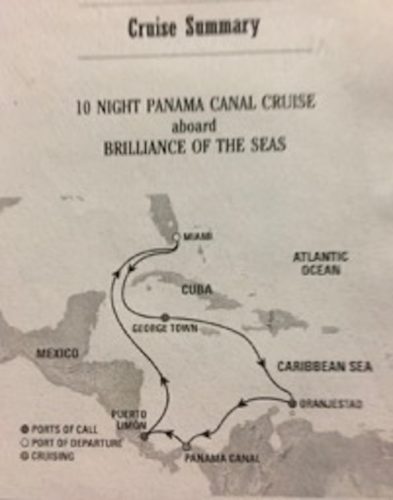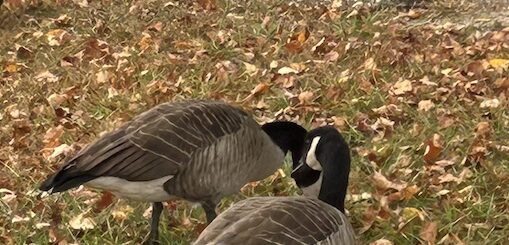Panama Canal Cruise
We cruised the Caribbean on the Royal Caribbean International Flagship, The Brilliance of the seas from April 8 – 20,2004. After flying from Boston to Miami, we got on board the ship in the afternoon of April 8. This was the second cruise that we have ever been on, and with very high expectation and excitement because of our great experience on board of Veendam, one of the cruise ships with Holland America, to Alaska.
These ships are floating resorts offering great accommodation, restaurants, casinos, outdoor area with swimming pools, Jacuzzis, spas, night clubs and duty free shopping. To add to that there are food courts, lounges, cafes, and bars where food, drinks, and tea and coffee stations are open 24 hours.
The fun and Pampering starts as soon as you get on board. Luggage is brought to your state room in record time. State rooms are very spacious with huge storage area and cupboard space. Decent size bathrooms are well equipped with the necessities, and are cleaned twice a day.
As soon as you get on board, and before you sail safety drill is carried out in a very orderly fashion. We sailed from Miami and cruised for two days and pristine, and most of all serene Caribbean lulled us, at least me into safety and great meditative mood thanking God for every little favor he offers. There was a reception and a show to welcome the passengers aboard on the first night.
Our first stop where we anchored was Grand Cayman Island which is one of the three Islands. Grand Cayman’s capital is George Town, . Its sister Islands are Cayman Brac, and Little Cayman which are separated from the Grand Cayman by 90 miles of sea and lie to the northeast of it. Grand Cayman itself is 500 miles directly south of Miami.
Caymans have a very interesting history. Christopher Columbus touched two mounds of earth, Cayman Brac, and Little Cayman, when freak winds pushed his ship where he spotted multitudes of turtles and named the islands, as”las Tortugas”. But later they were renamed Cayman Islands after Caiman, the Taino word for alligators.
Variety of people such as, pirates, refugees, shipwrecked, and more landed and settled on the islands. There are several myths about the buried treasures from pirate activities. Also there are stories of wrecked ships around the reef. There has been conclusive evidence of a wreck of ten ships, which were part of a convoy sailing to US. and Britain that wrecked on the reef.
Tourism and banking became the mainstay of the economy making Cayman Islands offshore banking center. Another most important aspect of its fame is its coral grounds which are finest in the Caribbean making it the most prosperous and most expensive country for its size. When a cruise liner makes a short stop it is impossible for people to see how prosperous the country is. But for them reality check comes when they start shopping and find out the cost and also the exchange rate. The fact that it is a British colony reflects the exchange rate because the pound is more expensive than the US dollar. It is also evident that it is a crown colony with both police uniforms and red pillar boxes of telephone booths.
Our next port of call was Oranjestad, Aruba. Caribbean Islands at one time or another were colonized by the Europeans: England, Portugal, Holland, Spain, and France. There were wars over the possession of these Islands. Aruba is a prime example of mixed influences of several different colonizer and indigenous people. Aruba’s language is called Papiamento (an Afro-Portuguese Creole language) which developed, and has been in use since 16th century, as a unique combination of Portuguese, Spanish, Dutch, English, African, and Indian words. This language is spoken only on the Dutch “ABC” Islands: Aruba, Bonaire, and Curacao.
Alonzo de Ojeda claimed the island for Spanish crown in 1499 but did not colonize thinking it a “useless Island” which meant that they did not have a motive to kill off the local Indian tribe, Arawak. Today many of the Arubans are of Arawakan descent.
In 1634 Dutch took over Aruba. Gold was not discovered until 1824, and then was mined until 1913. 3 million tons were extracted before its depletion. At that point island’s economy appeared grim. Later Aloe plant became the major industry and Aruba was major producer of Aloe, making it a major industry. Now Aruba depends on tourism. Its bustling economy with modern, colorful shopping malls and jewelry stores are the attraction for those who come to enjoy the sun and aqua blue waters of Aruba beaches. Six months of the year tourist from all over the world come to the island. A large number come on cruise liner looking for fun in the sun. Tourist spend a lot, and Arubans do what they can to entertain them.
As people disembark d from the cruise liner, they are faced with placards of tour operations giving a wide variety of choices of sightseeing. it was a beautiful day in Aruba. Downtown Aruba was quite close to the port area. We picked up one of a dozen tours offered to us by local tour organizers. After a little waiting and hassle we got a scenic drive tour which took us to the Rock Garden, Natural Bridge, and Gold Mill Ruins. It was informative. On our way we saw a lot of huge Cactuses which grow everywhere in Aruba. They even use cactuses to make fences around the houses to keep animals out.
Our next port of call was Panama Canal. We had two days at sea. Now was the time for the sea to show its volatility and character as it became very rough due to high winds. Since Panama Canal was the highlight of the cruise, we looked forward to getting there. The ship’s entertainment schedule was packed with activities keeping us busy. We arrived at Panama Canal at 6:45 am on Thursday, April 15th, 04. It was a very clear day and all the passengers gathered on the upper deck to watch the entrance to the locks. It was fascinating
Panama canal was built to find a short cut between Atlantic and Pacific Oceans. It was built across the country which had to cross a very hilly part. The Gatun lake, a man-made lake, sits halfway between eastern and western parts to connect the lake to the two ocean on either side. Canal architecture involves locks. To get to Gatun lake from the Atlantic Ocean three locks have to be crossed. The length of Panama canal is 51 miles. We entered the canal from the Atlantic side into Gatun Lake. A series of three locks raise the ship 26 meters to the lake. Since the lake itself sits at the highest point, ships have to be lowered in order to get to Pacific Ocean through the two locks on the other side. . Our cruise ship entered the Gatun Lake and, after a short stop, turned around to go back to the Atlantic Ocean for our returned journey to Costa Rica and back to Miami.
We were back on the ship and sailed at 8pm and were headed to our next port of call which was Puerto Limón, Costa Rica. After all nights cruising we arrived at the port excited to get to our scheduled Braulio Carillo National Park tour. When we disembarked, we realized that it was not just overcast but also rainy and cold. We had to return to the ship to get our warm clothes.
Buses were ready to take us to the area from where we were to be taken to the Aerial Tramway to go up to the canopy and be at eye level to the top of the trees. We were given a nice buffet lunch which was included in the price of $126/- and was a surprise. But the other surprise was that the drizzle turned to torrent which meant we had to buy rain capes if we wanted to go for our Rain Forest Canopy Aerial Tramway tour. While the tourist had to fork out extra amount for protection from rain, their gift shop did a brisk business by selling capes to 90% of the people taking the tour.
After lunch, anxious and excited we all lined up to go on the tour. They started loading the trams with a condition that only five passenger and a guide can go up in each one of them. It meant that some people had to break away from their family members or friends, for instance, in one of the trams a couple was told to sit separately to balance the weight because they were both on the heavy side. But, as usual, some people came forward to solve the problem and all went smoothly.
We went up gliding over the treetops in Aerial Tramway which provides bird’s eye view of the lush tropical Braulio Carillo National park but there was not even a bird to be seen. Although it was a bleak rainy day with very limited visibility, we saw occasional orchids, and there were some red flower like leaves which the guide called “hot lips” ( Apparently, these red leaves looked like flowers before their full growth- an intriguing highlight ).
Coming back down there were some birds, and the guide pointed out a sloth that looked like a big bird’s nest. Despite the bad weather it was exciting to see something which was once in a life time chance. the whole national park tour took 8 hours. After a long day we were back on the ship and ready to sail back to Miami as the cruise summary map shows.



















